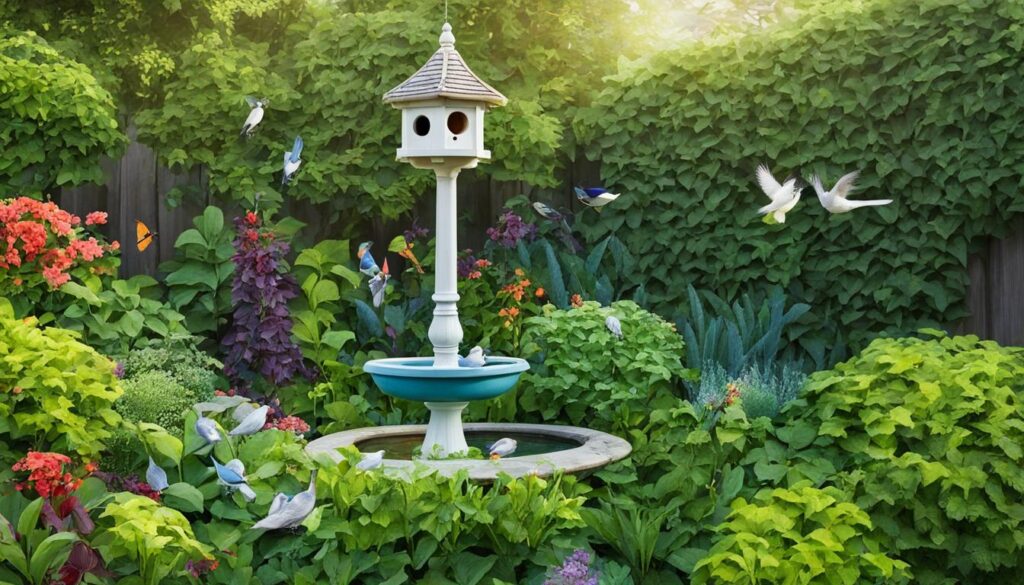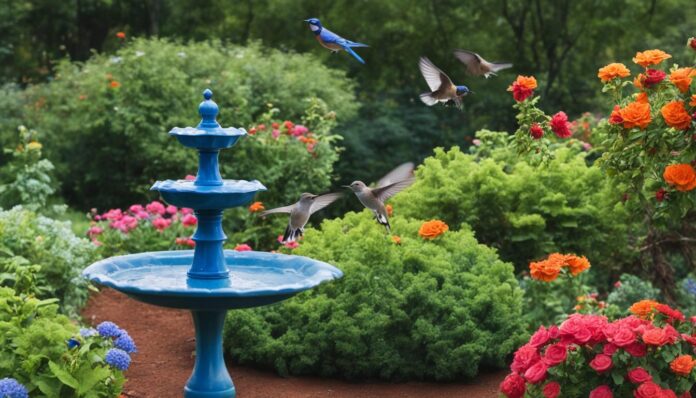Having a bird-friendly garden can bring you endless joy as you observe these beautiful creatures in their natural habitat. Not only will you get to enjoy their melodious songs and vibrant plumage, but you’ll also be contributing to the preservation of garden wildlife and promoting ecological gardening practices. By implementing a few simple tips and techniques, you can attract a wide variety of birds to your garden, creating a harmonious and vibrant ecosystem.
Key Takeaways:
- Preparing a bird-friendly garden provides a wonderful opportunity to observe and enjoy the beauty of diverse bird species.
- Creating varied plant heights and incorporating native trees are essential for attracting birds to your garden.
- Providing nesting boxes and protecting natural habitats contribute to the well-being of nesting birds.
- Offering a variety of food sources, such as bird feeders and fruit-bearing plants, is crucial for attracting birds.
- Adding a water source, like a birdbath or pond, and following additional tips like avoiding harmful chemicals, enhance the bird-friendly environment.
Importance of Varied Plant Heights and Native Trees
When designing your bird-friendly garden, it’s crucial to consider the height and diversity of your plants. Birds are naturally drawn to gardens with different levels of foliage and foraging opportunities, as it provides them with cover, shelter, and a variety of food sources. Incorporating native trees further enhances the ecological balance of your garden, attracting a diverse range of bird species.
Native trees, such as sycamore, alder, and oak, are perfectly suited to your region’s climate and soil conditions. These trees offer multiple benefits for bird populations, serving as valuable nesting sites, perching areas, and food sources. The presence of native trees in your garden promotes garden biodiversity, which is essential for creating a thriving ecosystem.
Here are some key reasons why varied plant heights and native trees are vital for attracting birds:
- Increased Garden Biodiversity: A garden with plants of different heights creates diverse habitats, supporting a greater variety of bird species. Some birds prefer to forage and nest in the lower shrubs, while others seek the canopies of taller trees. By providing a range of heights, you cater to the needs and preferences of various bird species, thereby increasing the overall biodiversity of your garden.
- Foraging Opportunities: Varied plant heights offer birds different levels of cover, allowing them to search for food and insects both at ground level and in the trees. This ensures a wider range of food sources and encourages the presence of more bird species in your garden.
- Nesting Sites: Native trees provide crucial nesting sites for birds. Their branches and foliage offer protection and secure locations for building nests. By incorporating native trees into your garden, you provide a safe haven for breeding and nesting birds, contributing to the overall ecological health of your garden and supporting population growth.
- Perching Areas: Birds rely on perching spots to rest, observe their surroundings, and sing their enchanting melodies. Native trees with sturdy branches and a suitable structure offer ample perching opportunities for birds, making your garden an attractive sanctuary for them.
Native Tree Examples
When selecting native trees for your bird-friendly garden, consider the following species:
| Native Tree Species | Description |
|---|---|
| Sycamore (Platanus spp.) | A majestic tree with broad leaves that provides excellent shade and nesting opportunities. It attracts a variety of bird species, including woodpeckers, warblers, and thrushes. |
| Alder (Alnus spp.) | A fast-growing tree that thrives near water. Alder trees attract birds such as finches, flycatchers, and kingfishers. |
| Oak (Quercus spp.) | A long-lived tree known for its beautiful foliage and acorns, which are a valuable food source for birds like jays, woodpeckers, and nuthatches. |
| [Add more native tree species relevant to the region] | [Add description] |
By incorporating a variety of plant heights and native trees into your garden, you create a natural and inviting environment for birds. This not only enhances the beauty of your garden but also contributes to the overall health and sustainability of the local ecosystem. Stay tuned for the next section to learn more about providing nesting boxes and habitat protection for the birds in your garden.
Providing Nesting Boxes and Habitat Protection

One effective way to attract birds to your garden and create a thriving ecosystem is by providing nesting boxes or birdhouses. Different bird species have specific requirements for their nesting spaces, so it’s important to choose the right nesting boxes for the birds you want to attract. By offering suitable nesting opportunities, you can encourage birds to make your garden their home and contribute to the overall biodiversity.
Creating nesting boxes is a simple and rewarding project that can be done with basic materials. There are numerous designs available online or at local birding stores, each tailored to specific bird species. Whether it’s a cozy wooden box for Eastern Bluebirds or an open-fronted design for Robins, providing suitable nest sites will not only attract these feathered friends but also offer you a unique opportunity to observe their nesting behaviors up close.
Protecting and preserving natural habitats in your garden is equally important for attracting birds and supporting their reproductive success. Tall shrubs, bushes, and trees provide essential shelter and safety for nesting birds. These plants not only serve as nesting sites but also provide valuable food sources and perching spots.
“The presence of natural and diverse vegetation in urban and suburban areas is critical for bird populations. It provides them with the necessary resources, ranging from food and nesting sites to protection from predators.”
Furthermore, taking steps to keep predators, such as cats, out of your garden is vital for the well-being of the bird population. Cats are known to pose a significant threat to birds, especially during nesting season. By implementing measures to keep cats away, such as using cat deterrents or creating barriers around the garden, you can help protect the nesting birds and ensure their safety.
Creating a bird-friendly garden involves not only providing nesting boxes but also preserving the natural habitats and safeguarding the birds from potential threats. By offering suitable nesting opportunities, shelter, and protection, you can enhance the garden ecosystem and enjoy the beauty of birdwatching right in your backyard.
Offering a Variety of Food Sources
When it comes to attracting birds to your garden, providing a diverse selection of food sources is essential. By offering a range of bird feeders and planting specific trees and shrubs, you can cater to the dietary preferences of different bird species, creating a haven for garden wildlife.
“A varied menu ensures a steady flow of feathery visitors to your garden.”
To optimize your bird feeding strategy, consider installing bird feeders with various seed options. Different bird species have distinct preferences when it comes to their culinary delights. For instance, goldfinches are particularly fond of thistle seeds, while hummingbirds are attracted to sugar water feeders. Providing a diverse range of bird feeders will increase the likelihood of attracting a wide array of feathered friends to your garden.
Additionally, incorporating fruit-bearing trees and shrubs into your garden is an excellent way to provide natural food sources for birds. Species such as toyon or pyracantha produce berries that birds find irresistible. These fruit-bearing plants not only offer nourishment but also contribute to the overall beauty and biodiversity of your garden.
Remember that different bird species have different dietary requirements, so it’s important to research the specific types of birds you want to attract. By providing an enticing menu of bird feeders and natural food sources, you’ll create a bird-friendly garden that will be teeming with life and delightful chirping.
Examples of Bird Feeders and Their Target Species
| Bird Feeder Type | Target Bird Species |
|---|---|
| Hopper Feeder | Sparrows, Cardinals, Grosbeaks |
| Tube Feeder | Finches, Chickadees, Nuthatches |
| Suet Feeder | Woodpeckers, Blue Jays, Orioles |
Creating a Water Source and Additional Tips
Birds need access to clean, fresh water for drinking, bathing, and cooling off, especially during the hot summer months. To attract more birds to your garden, consider adding a birdbath or a small pond garden. This will provide a vital water source for the avian visitors. Remember to clean the birdbath regularly to prevent the spread of diseases and keep the water inviting for birds.
In addition to providing water, there are other important tips for creating a bird-friendly garden. One crucial aspect is to avoid using harsh chemicals and pesticides. These can be harmful to birds and other garden wildlife. Instead, opt for natural alternatives or eco-friendly pest control methods to maintain a healthy garden ecosystem.
Furthermore, growing native plants is key to promoting garden biodiversity and attracting birds. Native plants have adapted to the local environment and provide valuable food sources and shelter for birds. Consider incorporating native flowers, shrubs, and trees into your garden to create a vibrant and diverse habitat for avian species.
Lastly, ensuring ample shelter and protection from predators is vital for the well-being of birds in your garden. Dense shrubs, tall grasses, and birdhouses provide safe havens for nesting and resting. By carefully considering these additional tips, you can transform your garden into a haven for feathered friends, promoting garden biodiversity and creating a thriving garden ecosystem.
FAQ
How can I create a bird-friendly garden?
To create a bird-friendly garden, you can start by considering the height and diversity of your plants. Incorporate a variety of native trees and plants to provide food sources, nesting sites, and perching areas. You can also attract birds by providing nesting boxes, protecting natural habitats, and keeping predators away.
What kind of plants should I include in my garden to attract birds?
Including native trees, such as sycamore, alder, oak, and other native species, is beneficial for attracting birds. Additionally, incorporating plants with varied heights and a range of flowers, berries, and seeds can attract a diverse range of bird species.
How can I attract specific bird species to my garden?
To attract specific bird species, consider their preferences for nesting spaces and food sources. Provide the appropriate nesting boxes or birdhouses and choose bird feeders with seeds or food that cater to the birds you want to attract. Planting specific fruit-bearing trees and shrubs can also attract certain bird species.
What can I do to protect birds’ habitats in my garden?
Protecting birds’ habitats in your garden can be done by preserving natural spaces, such as tall shrubs and bushes, which provide shelter and safety for nesting birds. You can also create a garden free from chemical pesticides that can harm birds and their natural ecosystem.
How can I provide water for birds in my garden?
You can provide water for birds in your garden by installing a birdbath or a small pond garden. Ensure the water is clean and fresh, especially during the summer months, and regularly clean the birdbath to prevent the spread of diseases. Birds require access to water for drinking, bathing, and cooling off.

